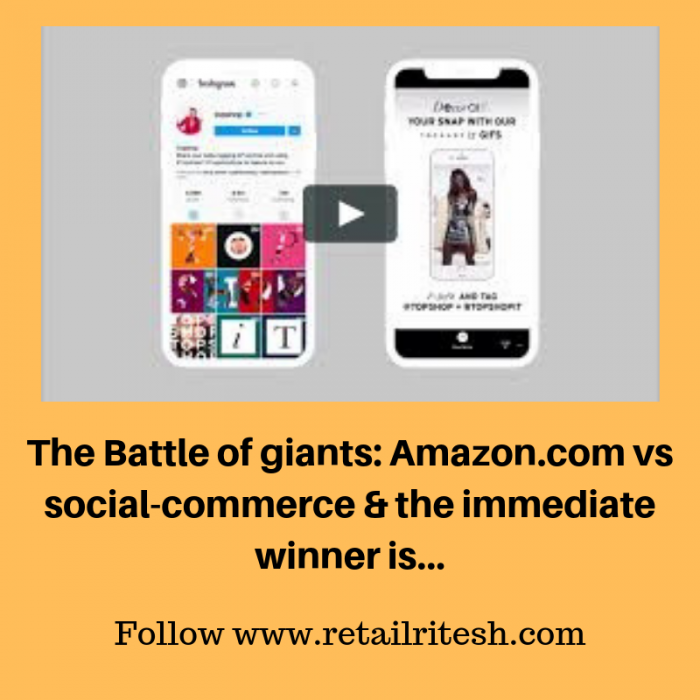The Battle of giants: Amazon.com vs social commerce & the immediate winner is …..
Recently I came across a post on social-commerce and my first reaction was blank… as I had no idea of what is social-commerce and its impact.
The Internet has changed the way we do business & is giving rise to new sectors and industries.
Social commerce got my curiosity and being an avid reader and researcher, I researched about social- commerce and now I am attempting to share my knowledge with my blog readers.
What Is Social Commerce?
Social commerce is defined as the ability to make a product purchase within the native social media experience.
For example, you can browse and compare products on Facebook and then make the purchase on Facebook itself vs. going to the company’s site to make the purchase. Or you can learn about a product in a tweet and make the purchase on Twitter itself.
How different it is from eCommerce sites:
Conventional eCommerce sites like Amazon.com use a sales funnel wherein the browser first lands on the homepage of the site, browses the categories, clicks the collection and then reads about the product descriptions and sorts his searches either on price or on brands and then finally lands on the check-out page. He then enters the payment details and completes the transaction.
In conventional eCommerce, the conversion rate from the home page to the checkout page is very low; most of the customers coming onto your homepage doesn’t end up buying.
In social-commerce, the purchase or check out option is given right in the post or sponsored post on the social media page.
Below is the example of Buy button on Instagram

Image from Social Media Examiner
Why social-commerce is gaining importance?
The answer lies in human emotion i.e. “being social” and “always seeking convenience”.
Social media platforms like Instagram have stories options wherein you have an option of “swipe up” which is basically a prompt, asking you to swipe up and takes you to the product check-out page.
Shoppable posts and stories allow brands and users to tag specific products wherever they are within posts or “stories.” This type of social shopping is relatively new, but with Instagram and Snapchat both launching their own version of the feature, it’s taken off quickly.
This feature enables brands to create a seamless experience for customers because the entire shopping experience stays within the social media app itself.
Result: As per digital commerce 360 study, 41% of brands giving it a try on Instagram.
Who is using social commerce?
“Social commerce” is driven heavily by the younger generation, according to the marketingweek study.
33% of 18- to 24-year-olds say they would like to purchase items directly on Facebook,
27% on Instagram and 20% on Twitter.
25- to 34-year-olds decline a bit;
30% on Facebook.
People 54- to 65-years-old? A disappointing 10%.
How does it impact Amazon.com and other eCommerce sites?
Social commerce has forced giant eCommerce sites to relook at their User experience i.e. to reach the check out page with minimal clicks.
It has forced conventional sites to reconsider their social engagement plan with their consumers.
Learn about Boom in subscription business model for male grooming products, click here.
Advantages of social commerce for brands
- Increase the number of conversations taking place about your products/company.
- Encourage peer recommendations and reviews.
- Social networks give you access to a highly engaged audience with sky-high purchasing intent. Customers who are actively researching products on social media are getting ready to make a real purchase. That means if you invest in getting those people into your store, it can have a big impact on your foot traffic and sales.
Case study: Meesho
This reseller platform was recognized by facebook.com when they announced that they are investing 25million USD in this Indian Platform.
Strategy:
Meesho did not participate in the war of the giants (Amazon, Flipkart, snapdeal) for the Indian eCommerce market rather focused on social commerce and created a huge market share for themselves.
Meesho has adjusted its focus as an enabler for people in India wanting to sell products using social media.
Primarily the focus is WhatsApp, the world’s most popular messaging app which counts India as its largest market with over 200 million monthly users.
The company providers sellers with products (which it sources from suppliers) and inventory management and other basic seller tools. In turn, sellers hawk their catalog to friends and family as they please. Meesho handles all payments and logistics, providing a cut of the transaction to sellers.
Sales typically happen between friends and family because there is a trusted relationship. Selling consistently to family members doesn’t seem like an easy task, but Meesho operates in a range of verticals, including fashion, living, cosmetics and more, which makes repeat purchase easier.
Interestingly, there’s no fixed price for products. That means that sellers can vary the price and even haggle with their customers just as they’d do in real life.
Meesho saw rising aspirations amongst the Indian housewives segment who wanted an option of hassle-free passive income.
Meesho has two million sellers registered to date but the goal is to reach 20 million by 2020.
A majority 80 percent are female because the startup first targeted housewives.
Nearly one-third of sellers are students and many others use the app part-time to add to an existing income source.
A Winning Differentiator:
Meshoo business taps into people’s trusted relationships and offer them incentives to sell products without requiring operating capital, the business has cut a lot of the expensive overheads associated with e-commerce.
Customer acquisition cost is low, for example, while there’s no need to dole out discounts, both of which are expensive line items for Amazon India and its rival Flipkart, which is now owned by Walmart.
To conclude I would quote Seth Godin’s statement which summarizes the social commerce completely.
“You can use social media to turn strangers into friends, friends into customers and customers into salespeople.”
Below is the video, I have tried to summarize the article:

About the author:
Ritesh Mohan is a passionate retail professional with over 20 years in the Retail sector, handling some of the biggest brands in beauty, fashion and fragrances retail & FMCG sector. He has been instrumental in the growth of some of the regional brands as well in the Middle East region. Ritesh specializes in Retail management, Product development, and Brand Management, Retail Operations, Sales Management, and Franchising & Business Management. He believes in empowering business owners with his wisdom & experience of around two decades in the industry.





November 18, 2020 @ 6:05 pm
Thank you f0r sharing such valuable insights.
November 19, 2020 @ 5:49 am
you are most welcome Reita, I am glad you liked the insights. we need to catch up soon for chai. regards, ritesh